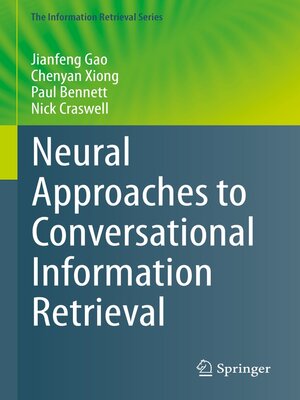Neural Approaches to Conversational Information Retrieval
ebook ∣ The Information Retrieval Series
By Jianfeng Gao

Sign up to save your library
With an OverDrive account, you can save your favorite libraries for at-a-glance information about availability. Find out more about OverDrive accounts.
Find this title in Libby, the library reading app by OverDrive.



Search for a digital library with this title
Title found at these libraries:
| Loading... |
This book surveys recent advances in Conversational Information Retrieval (CIR), focusing on neural approaches that have been developed in the last few years. Progress in deep learning has brought tremendous improvements in natural language processing (NLP) and conversational AI, leading to a plethora of commercial conversational services that allow naturally spoken and typed interaction, increasing the need for more human-centric interactions in IR.
The book contains nine chapters. Chapter 1 motivates the research of CIR by reviewing the studies on how people search and subsequently defines a CIR system and a reference architecture which is described in detail in the rest of the book. Chapter 2 provides a detailed discussion of techniques for evaluating a CIR system – a goal-oriented conversational AI system with a human in the loop. Then Chapters 3 to 7 describe the algorithms and methods for developing the main CIR modules (or sub-systems). In Chapter 3, conversational document search is discussed, which can be viewed as a sub-system of the CIR system. Chapter 4 is about algorithms and methods for query-focused multi-document summarization. Chapter 5 describes various neural models for conversational machine comprehension, which generate a direct answer to a user query based on retrieved query-relevant documents, while Chapter 6 details neural approaches to conversational question answering over knowledge bases, which is fundamental to the knowledge base search module of a CIR system. Chapter 7 elaborates various techniques and models that aim to equip a CIR system with the capability of proactively leading a human-machine conversation. Chapter 8 reviews a variety of commercial systems for CIR and related tasks. It first presents an overview of research platforms and toolkits which enable scientists and practitioners to build conversational experiences, and continues with historical highlights and recent trends in a range of application areas. Chapter 9eventually concludes the book with a brief discussion of research trends and areas for future work.
The primary target audience of the book are the IR and NLP research communities. However, audiences with another background, such as machine learning or human-computer interaction, will also find it an accessible introduction to CIR.






